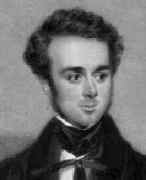◀ ▲ ▶History / 19th-century / Person: O'Brien, Matthew
Person: O'Brien, Matthew

Matthew O'Brien was an Irish mathematician best known for his theory and application of the vector method.
Mathematical Profile (Excerpt):
- Matthew's schooling was in Ennis but he left there in July 1830, when he was sixteen years old, and entered Trinity College Dublin.
- O'Brien graduated from Trinity College Dublin in 1834 and, on 3 November of the same year, he matriculated at Caius College, Cambridge.
- At Cambridge O'Brien was tutored by William Hopkins and soon showed great promise.
- In 1838 O'Brien graduated with a B.A. and was Third Wrangler in the Mathematical Tripos, meaning that he was ranked third in the list of candidates graduating with a First Class degree.
- One year ahead of O'Brien at Cambridge were James Joseph Sylvester, Duncan Gregory and George Green who all were Wranglers in the Mathematical Tripos examinations of 1837.
- Another who was doing interesting work in areas to which O'Brien later made major contributions was the Irishman Robert Murphy although he had to leave Cambridge when O'Brien was halfway through his undergraduate studies.
- Remaining at Cambridge after graduating with a B.A., O'Brien published On the variation of the longitude of the perihelion in the planetary theory in the Cambridge Mathematical Journal in 1838.
- In 1841 O'Brien was awarded an M.A. but in the same year resigned his fellowship at Caius College, Cambridge.
- He describes himself as 'Rev M O'Brien, M.A., Late Fellow of Caius College, Cambridge' on the title page so by this time O'Brien had been ordained.
- On 8 March 1854 O'Brien was appointed as Professor of Natural Philosophy and Astronomy in King's College, London.
- He describes himself as 'Rev M O'Brien, Professor of Natural Philosophy and Astronomy in King's College, London, and Late Fellow of Caius College' on the title page.
- O'Brien retained his professorship of Natural Philosophy and Astronomy in King's College, London until 1854 although he took on an additional appointment as lecturer in practical astronomy at the Royal Military Academy, Woolwich, in 1849.
- In 1854 O'Brien applied for the position of Professor of Mathematics at the Royal Military Academy in Woolwich.
- Despite the quality of the other applicants, O'Brien was appointed on 2 August 1854.
- He wrote a letter on 9 August in which he was clearly upset that O'Brien had been appointed rather than himself (he lists his referees who supported his application "in the strongest language in which a recommendation could be clothed").
- He also sounds surprised that Stokes "was one of the unappointed candidates." We look in a moment at O'Brien's research contributions, but let us say here that Sylvester did not have long to wait to be appointed Professor of Mathematics at the Royal Military Academy in Woolwich since O'Brien died in 1855 and Sylvester filled his chair.
- After becoming ill, O'Brien had travelled to Petit Ménage, Jersey, in order to recover his health.
- We know little of O'Brien's private life but we do know that he had a son, Arthur Evanson O'Brien, who was born at Norwood, Middlesex, on 25 January 1849.
- We must return now to give an indication of the mathematical contributions that O'Brien made in addition to the books that we have mentioned above.
- O'Brien found an error in one of Kelland's papers which he pointed out.
- Kelland replied with a paper justifying his results and O'Brien responded again with a more detailed description of Kelland's error.
- The most significant of O'Brien's contributions is his early work on the vector calculus before the work of J Willard Gibbs and Oliver Heaviside which was only developed 30 years after O'Brien's death.
- It is clear that O'Brien made a substantial contribution with the introduction of the vector and scalar product but, perhaps not surprisingly for this early attempt, there were weaknesses in his approach.
- O'Brien's notation is different from the modern one.
- He wrote u × v for what today is called the dot product u.v. O'Brien also uses u.v or Du.v for what today is called the vector product.
- O'Brien begins by setting out the fundamental equations of motion of a rigid body ...
- In 1847 O'Brien published another paper on vectors in which he tried to develop ideas of differential geometry.
- By 1851 O'Brien had realised that his ideas had not made an impact and so he tried to make them more acceptable.
- O'Brien's work was completely overshadowed by this 'publicity campaign'.
- O'Brien might have achieved much more had he had more leisure to pursue his research.
Born 1814, Ennis, County Clare, Ireland. Died 22 August 1855, Petit Ménage, Jersey.
View full biography at MacTutor
Tags relevant for this person:
Astronomy, Origin Ireland
Thank you to the contributors under CC BY-SA 4.0! 

- Github:
-

- non-Github:
- @J-J-O'Connor
- @E-F-Robertson
References
Adapted from other CC BY-SA 4.0 Sources:
- O’Connor, John J; Robertson, Edmund F: MacTutor History of Mathematics Archive
